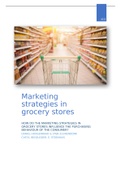2022
Marketing
strategies in
grocery stores
HOW DO THE MARKETING STRATEGIES IN
GROCERY STORES INFLUENCE THE PURCHASING
BEHAVIOUR OF THE CONSUMER?
DANIEL HOOGENRAAD & STIJN ZUURENDONK
CV6TA, BEGELEIDER: E. STEENHUIS
, 1
Summary
In this profile paper, we will investigate and describe which marketing strategies are used by
supermarkets, and how these strategies influence consumer buying behaviour. In the next
section, we explored and described why people make irrational choices. This is of course
related to the marketing strategies. This results in the main question that we have answered:
“How do the marketing strategies in grocery stores influence the purchasing behaviour of the
consumer?” We chose to investigate this because marketing appealed to us. We noticed that
we come across different kinds of marketing every day. We also often come across this in
the supermarket, where we both work. Therefore, we thought it would be interesting to
investigate how supermarkets use different marketing strategies to influence consumer
buying behaviour.
For the theoretical framework, we have often conducted research using the internet, in
particular websites with scientific articles, in order to guarantee the reliability and
representativeness of our given information. To further explore the theory, we conducted a
test, interviewed a supermarket manager, and finally conducted a survey. This test and
survey provide insight into how the tested people react to the marketing strategies and thus
indicates whether they work or not.
Our results show that the Anchoring Effect, the Decoy Effect, and Serial Positioning Effect
are of great importance in consumer choices. The theory also showed that colour, smell and
background music are of great importance. In our survey, we focused exclusively on colour
and saw that colour did have a major influence on purchasing behaviour. Different colours
evoke different emotions in the consumer. So you have to match the colour well to the
emotion you want your product to evoke. There are many different causes behind irrational
choices. First, there are uncertain choices, second, there are emotional choices, and finally,
there are scarcity choices. In all these different choices, the satisfaction of the pleasure
centre is central. Within the pleasure centre, you have all kinds of unconscious needs, such
as a craving for bread. Entrepreneurs can use this to influence the purchasing behaviour of
consumers. Our results of the tests we did show that a small improvement in our question
formulation has a major influence on the choice of the respondent. For example, in our
research, we saw that our outcome was a lot different when the question was adjusted.
So we can conclude that the marketing strategies ensure that consumers are pressured into
making irrational choices by using different marketing strategies. In this way, the consumer
often chooses in favour of, in this case, the supermarket. The different strategies respond to
the functioning of the brain and the subconscious.
, 2
Acknowledgements
At the start of the profile assignment, we were immediately faced with the question: which
subject are we going to choose. With our economically oriented curriculum and work
experience at Albert Heijn as a ‘filling team employee’, the choice was made quickly. Our
topic is relevant, because marketing is a timeless tool to influence people's purchasing
behaviour, and will continue to evolve in the future. We already had some prior knowledge of
how marketing works and how the subconscious relates to it. To properly investigate how
this works, we thought it would be useful to investigate a specific industry: supermarkets.
We would like to thank the supermarket manager of the local Albert Heijn, R. Becking, for the
interview. He had little time during the renovation of his shop, but despite everything, he was
able to free up a spot in his agenda, just for our research. I would also like to thank all the
people who participated in the survey. We would never have been able to complete this
research without their cooperation.
Now that we grabbed your attention and the profile paper lays in front of you, we wish you a
lot of pleasure reading.
Daniel Hoogenraad & Stijn Zuurendonk
, 3
Table of Contents
Introduction…………………………………………….…………………………………………………………………….p.4
Chapter 1: How do stores use product presentation to influence consumers' irrational buying behaviour?
1.1 What is marketing and what is manipulation?.................................................................................................p.5
1.2.1 The Anchoring Effect……………………………..…………………………………………………………………..p.5
1.2.2 The Decoy Effect………………………………………..…………………………………………………p.6
1.2.3 The Serial Position Effect……………………………………………………………………….…………p.7
1.2.3.1 Test………………………………………………………………………………………………...……...p.8
1.3 The location of products………………………………………………………………………………………………..p.9
1.3.1 The shop layout…………………………………………………………………………………………….p.9
1.3.2 The shelf layout……………………………………………………………………………………..…….p.11
1.4 How do the weekly discounts determine the presentation of a product in the store?.....................................p.12
1.5 Colour, scent and background music………………………………………………………………...……………..p.13
1.5.1 Colour………………………………………………………………………………………………………p.13
1.5.2 Fragrance………………………………………………………………………………………………….p.14
1.5.3 Background music………………………………………………………………………………………..p.15
Chapter 2: Why is it that people make such irrational choices in their purchasing behaviour?
2.1 Irrational choices by the pleasure centre in the brain………………………………………………………..……p.16
2.2 Different kinds of irrational choices………………………………………………………………………………….p.17
2.2.1 Uncertain choices…………………………………………………………………………………………p.18
2.3 Choices due to scarcity…………………………………………………………………………………………...…..p.19
Chapter 3: Our own research by means of an interview and survey.
3.1 Interview with Albert Heijn manager R. Becking……………………………………………………………...……p.20
3.2 Survey…………………………………………………………………………………………………………………..p.22
3.2.1 What do we investigate with the survey?.......................................................................................p.22
3.2.2 The questions from the survey…………………………………………………………………………..p.23
3.2.3 Results of the survey……………………………………………………………………………………..p.24
Conclusion…………………………………………………………………………………………………………….……p.26
Discussion…………………………………………………………………………………………………………..………p.28
Appendix…………………………………………………………………………………………………………………….p.30
Source list………………………………………………………………………………………………………………..…p.31
Logbook……………………………………………………………………………………………………………………..p.33
Introduction




